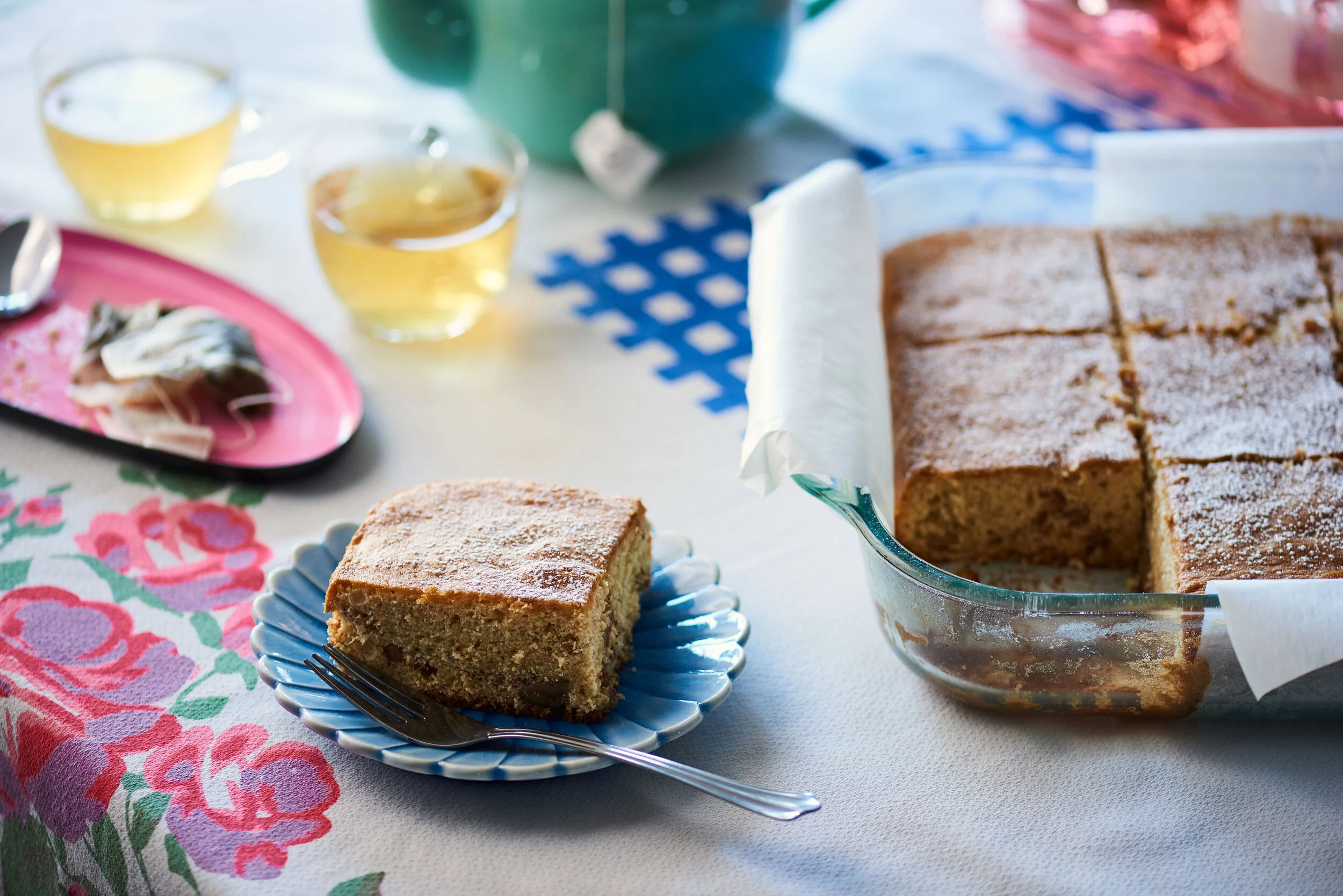A Summertime Polish Plum Cake Connects Four Generations
Photos by Penny De Los Santos
Shared by Hannah Shephard
Recipe Roots: Niwka, Poland > Munich > New York City > Flint, MI > Queens, NY > Bangor, ME and Gainesville, FL > New York City
Early during World War II, Hannah Shephard’s paternal grandparents Helen and Berek weren’t married yet — each was dating someone else who they lost to the war. The couple came together quickly in an “unlikely union,” says Hannah’s father Sol. “No one thought this was a couple.” But the two were married in November of 1941 with a marriage certificate that was issued by the Nazis.
Helen and Berek
Living in a strip of Poland between the Third Reich and the Soviet Union, Helen and Berek were sent to a series of labor camps, often imprisoned in adjoining men’s and women’s camps — risking their lives at times to save the other’s.
In one camp, Helen worked in an office where lists of men to be deported were generated. The men were sent to one of two camps. Through an underground information network, she learned the camp where Berek was to be sent was worse than the other. At night, Helen snuck back into the office with friends and retyped the lists, sending her husband to the less severe camp. “At risk of her life…. She saved my dad’s life,” Sol says. “At the end of the war, my dad was basically able to save her life.”
He worked in a factory outside of the camp either as a tailor or as a shoemaker for SS officers. Nearby the SS stored food and perfume. “He would steal the stuff… and bribe the guards at his camp,” says Sol. Those guards would in turn bribe guards at the women’s camp to allow Helen to have an extra piece of bread.
After the war, the couple tried to return to their home in Poland, but realized they couldn’t rebuild their lives there. They moved to Munich, where Sol and Abe were born, and finally to the United States. In the family, “the war was always present,” says Sol, but “It was only in their later years that I heard a lot of the stories of the war. They wanted to make a new life.”
*
In Flint, Michigan, where the family settled and opened a women and children’s clothing store, a plum cake with a pie-like crust “became part of our late summer lives,” says Abe, made when Italian plums were in the markets. “She thought the [Italian] plums were so precious,” adds Abe’s wife Judy. No one is certain where the recipe came from, but the brothers believe it likely predates the family’s emigration from Europe.
Helen continued to make the cake — sometimes with apples — as a grandmother when she moved into the duplex where Hannah lived, splitting her time between her two sons’ families in Maine and Florida. No one was ever able to capture the recipe exactly as Helen made it, though Hannah tried when she was about 8-years-old. “It was ridiculous. It was like ‘a pinch of this’.... [and] ‘two of these.’” Hannah clarified: “How many was that?” Helen responded: “Three,” Hannah says laughing.
The family never captured the recipe exactly, Hannah concedes, but they’ve created something that tastes like the original. Last fall, Hannah made the rendition with apples with her daughters, who are 5- and 11-years-old. “They kind of understand a little bit that their mommy also had a bubbie,” says Hannah.
Plum Cake
Makes: 1 10-inch cake
Total Time: 90 minutes
Ingredients
Non-stick spray
For the dough:
1 ½ cups flour
1 teaspoon baking powder
1 stick/ ½ cup unsalted butter, room temperature
½ cup sugar
1 egg, room temperature
¾ teaspoon vanilla extract
For the filling and assembly:
1 teaspoon ground cinnamon
¼ cup raisins
1 ½ - 2 ½ pounds Italian plums (or 8-10 black plums), halved and pitted
1 tablespoon melted butter
1 teaspoon sugar
Preparation
Grease a pie pan with non-stick spray.
Make the dough: Mix the flour and baking powder in a small bowl and set aside.
In a stand mixer fitted with a paddle attachment, cream the butter and sugar until it is light, fluffy, and smooth, about 5 minutes. Add in the egg and vanilla, and mix until well combined. Gradually add the flour and baking powder and mix until a dough is formed.
Divide the dough into 2 equal portions. Roll out each portion between two sheets of parchment to ¼-inch thick, and refrigerate on a baking sheet for 8-10 minutes, until slightly firm but still malleable.
Assemble: Gently line the bottom of the pan with one piece of dough. Place the plums cut side down in a single layer. Evenly sprinkle the raisin and cinnamon on top of the plums. Gently place the second piece of dough on top of the plum filling. Using your fingertips, gently crimp the dough edges to seal. Refrigerate uncovered for 30 minutes.
Preheat the oven to 350 degrees. Take out the pie, and brush the crust with melted butter and sprinkle the top with sugar.
Cut a few slits in the crust to let steam escape, and bake for 50-60 minutes until the top crust is golden, the plums are cooked, and the bottom crust is baked. Serve warm or at room temperature.











